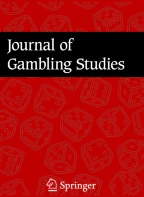The present research describes the development and validation of a cognitive assessment instrument, the Drake Beliefs about Chance (DBC) inventory, designed to determine and quantify erroneous beliefs about games of chance. Principal components analyses showed that the DBC assesses two primary dimensions, Illusion of Control and Superstition. Correlation analyses showed that scores on these two dimensions are related to higher frequency of gambling behaviors in both adults from the general population and clients from gambling treatment centers. Of the two sets of erroneous beliefs, Illusion of Control was a better predictor of gambling than Superstition. This investigation provides additional evidence that participants in games of chance such as casino gamblers possess certain classes of erroneous beliefs regarding the games they play.
Similar content being viewed by others
References
S. Jefferson R. Nicki (2003) ArticleTitleA new instrument to measure cognitive distortions in video lottery terminal users: The Informational Biases Scale (IBS) Journal of Gambling Studies 19 387–403 Occurrence Handle10.1023/A:1026327926024
J. Joukhador A. Blaszczynski F. Maccallum (2004) ArticleTitleSuperstitious beliefs in gambling among problem and non-problem gamblers: preliminary data Journal of Gambling Studies 20 171–180 Occurrence Handle10.1023/B:JOGS.0000022308.27774.2b
R. Ladouceur C. Sylvain C. Boutim C. Doucet (2002) Understanding and treating the pathological gambler John Wiley & Sons, Ltd. West Sussex, England
R. Ladouceur C. Sylvain H. Letarte I. Giroux C. Jacques (1998) ArticleTitleCognitive treatment of pathological gamblers Behavior Research and Therapy 36 1111–1119 Occurrence Handle10.1016/S0005-7967(98)00086-2
R. Ladouceur M. Walker (1996) A cognitive perspective on gambling P. M. Salkovskis (Eds) Trends in cognitive and behavioural therapies John Wiley & Sons, Ltd New York
P. M. Muchinsky (1996) ArticleTitleThe correction for attenuation Educational and Psychological Measurement 56 63–75
InstitutionalAuthorNameNational Opinion Research Center (1999) Gambling impact and behavior study: final report to the national gambling impact study commission University of Chicago Press Chicago
InstitutionalAuthorNameNational Research Council (1999) Pathological gambling: a critical review National Academy Press Washington D.C
Shaffer, H. J., Hall, M. N., & Vander Bilt, J. (1997). Estimating the prevalence of disordered gambling behavior in the United States and Canada: a meta-analysis. Kansas City: Project report to the National Center for Responsible Gambling.
T. A. Steenbergh A. W. Meyers R. K. May J. P. Whelan (2002) ArticleTitleDevelopment and validation of the Gambler’s Beliefs Questionnaire Psychology of Addictive Behaviors 16 143–149 Occurrence Handle10.1037/0893-164X.16.2.143
B. Thompson L. G. Daniel (1996) ArticleTitleFactor analytic evidence for the construct validity of scores: A historical overview and some guidelines Educational and Psychological Measurement 56 197–208
J. Welte G. Barnes W. Wieczorek M. Tidwell J. Parker (2002) ArticleTitleGambling participation in the U. S. Results from a national survey Journal of Gambling Studies 18 313–337 Occurrence Handle10.1023/A:1021019915591
Author information
Authors and Affiliations
Corresponding author
Rights and permissions
About this article
Cite this article
Wood, W.S., Clapham, M.M. Development of the Drake Beliefs about Chance Inventory. J Gambl Stud 21, 411–430 (2005). https://doi.org/10.1007/s10899-005-5556-4
Issue Date:
DOI: https://doi.org/10.1007/s10899-005-5556-4
